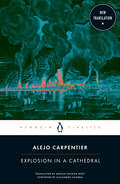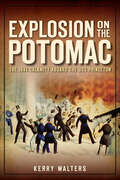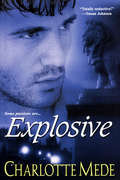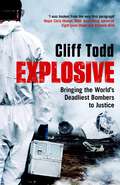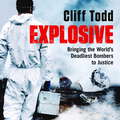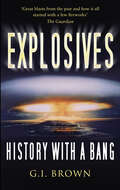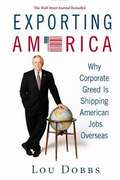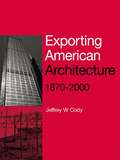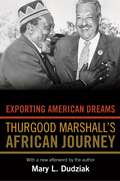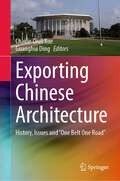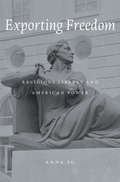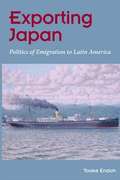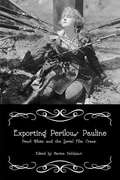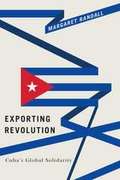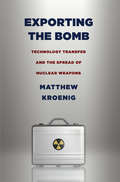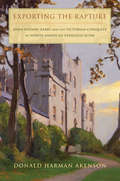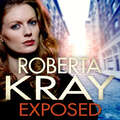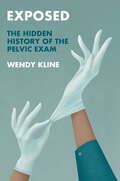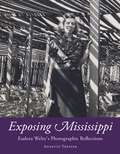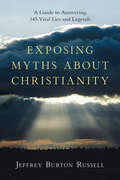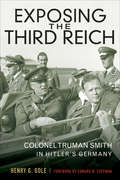- Table View
- List View
Explosion in a Cathedral
by Alejo CarpentierOne of Cuba&’s—and Latin America&’s—greatest historical novels, about imperial conquest carried out under the guise of liberation, in its first new English translation in sixty years and featuring a new foreword by Alejandro ZambraA Penguin ClassicWhen he arrives in Cuba at the close of the eighteenth century, Victor Hugues, a merchant sailor from Marseille, brings with him not only the idealism of the French Revolution but also its ambition and bloodlust. Landing at the Havana doorstep of a trio of wealthy, eccentric Creole orphans, he sweeps them across the Caribbean Sea to Guadeloupe, whose enslaved Africans he frees only then to exploit them in his fight against the British for colonial sovereignty. What ensues in Alejo Carpentier&’s swashbuckling, magical realist masterpiece is an explosive clash between the New World and the Old World, and between revolutionary ideals and the corrupting allure of power.For more than seventy-five years, Penguin has been the leading publisher of classic literature in the English-speaking world. With more than 2,000 titles, Penguin Classics represents a global bookshelf of the best works throughout history and across genres and disciplines. Readers trust the series to provide authoritative texts enhanced by introductions and notes by distinguished scholars and contemporary authors, as well as up-to-date translations by award-winning translators.
Explosion on the Potomac: The 1844 Calamity Aboard the USS Princeton (Disaster Ser.)
by Kerry WaltersIn 1844, the USS "Princeton" was the most technologically sophisticated warship in the world. Its captain, Robert Stockton, and President John Tyler were both zealous expansionists, and they hoped that it would be the forerunner in a formidable steam-powered fleet. On a Potomac cruise intended to impress power brokers, the ship's main gun--the Peacemaker--exploded as the vessel neared Mount Vernon. Eight died horribly, while twenty others were injured. Two of Tyler's most important cabinet members were instantly lost, and the president himself had a near miss--making it the worst physical disaster to befall a presidential administration. The tragedy set off an unpredictable wave of events that cost Tyler a second term, nearly scuttled plans to add Texas to the Union and stirred up sectional rancor that drove the nation closer to civil war. Author Kerry Walters chronicles this little-known disaster that altered the course of the nation's history.
Explosive
by Charlotte MedeLondon, 1818. A beautiful, brilliant woman and a cynical, aristocratic spy are forced into a desperate mission to decipher a secret code that could change the face of Europe forever. . . ExplosiveGray Dalton, the Marquess of Blackburn, wakes in a dark London cell staring down a gun barrel. Devon Caravelle, alleged mistress of a deadly French aristocrat, has been sent to ensure Blackburn's cooperation in a secret plot to unlock the mysteries buried within Beethoven's Third Symphony, the Eroica. It's terribly convenient and just as Blackburn planned. And taking the lady hostage is--if not terribly gentlemanly--not very difficult. Resisting her dangerous allure, on the other hand, is. Suddenly, the man famed for his cold-blooded control, wants a woman fiercely, wildly, forever. . . Devon Caravelle has loved two things in her life: music and her father. She would do anything to discover his murderer and clear his name, even if it means forcing the contemptuous, debauched Marquess to her aid. But when he turns the tables and takes her prisoner, she is not prepared for his skillful seduction or her white-hot response. . . It was supposed to be a seduction each side intended to win easily. Instead, the first spark unleashes an untamed passion in a game where all rules are forfeit and every move brings them closer to an unspeakable danger. . .
Explosive: Bringing the World's Deadliest Bombers to Justice
by Cliff ToddTHE STORY OF BRITAIN'S LEADING FORENSIC EXPLOSIVES SCIENTIST, WHO FOR NEARLY THREE-DECADES INVESTIGATED SOME OF THE MOST PROMINENT NATIONAL AND INTERNATIONAL CRIMINAL BOMB ATTACKS IN HISTORY.Cliff Todd devoted his life to bringing bomb makers to justice. He and his colleagues at the Ministry of Defence's Forensic Explosives Laboratory are the unsung heroes of terrorist bomb attacks - the men and women in white suits who piece together who planted the bombs, what a device consisted of and how the perpetrators might give themselves away.They played a pivotal role in uncovering the secrets behind some of the world's most horrifying terrorist outrages. Explosive tells the stories of these high-profile cases and details, for the first time, the contribution Todd and his team made in tracking down bombers during a time when Britain was under attack first by the IRA and then by Islamic extremists inspired by al-Qaeda.Explosive takes the reader into the murky world of the amateur bomb maker, and reveals what Todd's department achieved in many now infamous attacks, including the device concealed in a radio cassette player that brought down Pan Am Flight 103 over Lockerbie, the IRA attacks on Warrington in Cheshire, the Bali nightclub bombings of 2002, and the 7/7 onslaught in central London that claimed 56 lives and injured 784 others in 2005.In Explosive, Todd takes us step by step through the investigations, explaining the chemistry, the forensic work and the emotional toll on him and his staff as they sought to recreate and understand what had happened at some of the most shocking tragedies in modern peacetime history.
Explosive: Bringing the World's Deadliest Bombers to Justice
by Cliff ToddTHE STORY OF BRITAIN'S LEADING FORENSIC EXPLOSIVES SCIENTIST, WHO FOR NEARLY THREE-DECADES INVESTIGATED SOME OF THE MOST PROMINENT NATIONAL AND INTERNATIONAL CRIMINAL BOMB ATTACKS IN HISTORY.Cliff Todd devoted his life to bringing bomb makers to justice. He and his colleagues at the Ministry of Defence's Forensic Explosives Laboratory are the unsung heroes of terrorist bomb attacks - the men and women in white suits who piece together who planted the bombs, what a device consisted of and how the perpetrators might give themselves away.They played a pivotal role in uncovering the secrets behind some of the world's most horrifying terrorist outrages. Explosive tells the stories of these high-profile cases and details, for the first time, the contribution Todd and his team made in tracking down bombers during a time when Britain was under attack first by the IRA and then by Islamic extremists inspired by al-Qaeda.Explosive takes the reader into the murky world of the amateur bomb maker, and reveals what Todd's department achieved in many now infamous attacks, including the device concealed in a radio cassette player that brought down Pan Am Flight 103 over Lockerbie, the IRA attacks on Warrington in Cheshire, the Bali nightclub bombings of 2002, and the 7/7 onslaught in central London that claimed 56 lives and injured 784 others in 2005. In Explosive, Todd takes us step by step through the investigations, explaining the chemistry, the forensic work and the emotional toll on him and his staff as they sought to recreate and understand what had happened at some of the most shocking tragedies in modern peacetime history.(P)2021 Headline Publishing Group Limited
Explosives: History with a Bang
by G I BrownThis entertaining and informative book tells the dramatic tale of explosives from gunpowder to the H-bomb. Laying the emphasis on the lives of the people involved, on the diverse uses of explosives and on their social and historical impact, the author relates a story of remarkable international and human endeavour. Many of those involved - Roger Bacon, Guy Fawkes, Alfred Nobel, Robert Oppenheimer - are famed worldwide; others, such as C F Schonbein, William Bickford, Sir Frederick Abel and Charles E Munroe, though less well-known, also played critical roles. Alongside their achievements, this book highlights the uses and impact of explosives in both war and terrorism, and in civil engineering, quarrying, mining, demolition, fireworks manufacture and shooting for sport. In many cases explosives are seen to have had a significant historical impact as, for example, in the early use of gunpowder in the American Civil War, the defeat of the Spanish Armada, and the worldwide opening up of canals and railways.
Expo 67
by Johanne Sloan Rhona Richman KenneallyExpo 67, the world's fair held in Montreal during the summer of 1967, brought architecture, art, design, and technology together into a glittering modern package. Heralding the ideal city of the future to its visitors, the Expo site was perceived by critics as a laboratory for urban and architectural design as well as for cultural exchange, intended to enhance global understanding and international cooperation. This collection of essays brings new critical perspectives to Expo 67, an event that left behind a significant material and imaginative legacy.The contributors to this volume reflect a variety of interdisciplinary approaches and address Expo 67 across a broad spectrum ranging from architecture and film to more ephemeral markers such as postcards, menus, pavilion displays, or the uniforms of the hostesses employed on the site. Collectively, the essays explore issues of nationalism, the interplay of tradition and modernity, twentieth-century discourse about urban experience, and the enduring impact of Expo 67's technological experimentation. Expo 67: Not Just a Souvenir is a compelling examination of a world's fair that had a profound impact locally, nationally, and internationally.
Export Agriculture and the Crisis in Central America
by Robert G. WilliamsBefore social unrest shook the region in the 1970s, Central America experienced more than a decade of rapid export growth by adding cotton and beef to the traditional coffee and bananas. Williams shows how the rapid growth contributed to the present social and political crisis, examines the causes of the export boom and who benefited from it, and shows the impact of the boom on land use, the ecology, and the conditions of life in the rural areas.
Exporting America: Why Corporate Greed is Shifting American Jobs Overseas
by Lou DobbsConsequences of free trade without corporate and government restraint.
Exporting American Architecture 1870-2000 (Planning, History and Environment Series)
by Jeffrey W. CodyThe export of American architecture began in the nineteenth century as a disjointed set of personal adventures and commercial initiatives. It continues today alongside the transfer of other aspects of American life and culture to most regions of the world. Jeffrey Cody explains how, why and where American architects, planners, building contractors and other actors have marketed American architecture overseas. In so doing he provides a historical perspective on the diffusion of American building technologies, architectural standards, construction methods and planning paradigms. Using previously undocumented examples and illustrations, he shows how steel-frame manufacturers shipped their products abroad enabling the erection of American-style skyscrapers worldwide by 1900 and how this phase was followed by similar initiatives by companies manufacturing concrete components.
Exporting American Dreams: Thurgood Marshall's African Journey
by Mary L. DudziakMary Dudziak's Exporting American Dreams tells the little-known story of Thurgood Marshall's work with Kenyan leaders as they fought with the British for independence in the early 1960s. Not long after he led the legal team in Brown v. Board of Education, Marshall aided Kenya's constitutional negotiations, as adversaries battled over rights and land--not with weapons, but with legal arguments. Set in the context of Marshall's civil rights work in the United States, this transnational history sheds light on legal reform and social change in the midst of violent upheavals in Africa and America. While the struggle for rights on both continents played out on a global stage, it was a deeply personal journey for Marshall. Even as his belief in the equalizing power of law was challenged during his career as a Supreme Court justice, and in Kenya the new government sacrificed the rights he cherished, Kenya's founding moment remained for him a time and place when all things had seemed possible.
Exporting Chinese Architecture: History, Issues and “One Belt One Road”
by Guanghui Ding Charlie Qiuli XueThis book studies the unexplored history of China-aided architecture erected in the developing world since the 1950s. By 2019, over 1,000 buildings had been delivered to more than 160 countries, including parliament houses, convention centers, stadiums, gymnasiums, theaters, schools, hospitals, libraries, railways, and stations. These projects, which have played a significant role in promoting economic transformation, cultural engagement and social and environmental well-being, have largely been overlooked or misunderstood by the international community. Why did China donate so many foreign-aid buildings? How were these buildings built in the remote land of developing countries with intricate influences and limited resources? Have they helped modernize the recipient countries? The authors of this book use a wide range of representative projects built in different historic periods and geographical locations as case studies to address the above questions from various perspectives. This book fills an enormous gap in modern architecture in China and the world. It offers architectural students and scholars in various disciplines the necessary knowledge on "diplomatic architecture"; informs architects the appropriate methods of cross-border design and low-tech building; teaches government officials the best practice of donating and receiving foreign-aid buildings; and enhances public awareness of cultural diversity in Asia, Africa, Oceania, and Latin America. With abundant first-hand materials, historical pictures, and drawings, the book is a must-read for those who are interested in modern architecture and developmental aid in the world. China’s architecture abroad, notably in Africa and Asia, has been perceived with both fascination and anxiety. Based on a wealth of sources often difficult to access for scholars from outside China, this book links the history and present of China’s architectural mobilities in ways that will stimulate new debates in architectural history and urban studies. - Łukasz Stanek, Professor of Architectural History, The University of Manchester, UK
Exporting Freedom: Religious Liberty and American Power
by Anna SuReligious freedom is recognized as a basic human right, guaranteed by nearly all national constitutions. Anna Su charts the rise of religious freedom as an ideal firmly enshrined in international law and shows how America's promotion of the cause of individuals worldwide to freely practice their faith advanced its ascent as a global power.
Exporting Japan: Politics of Emigration to Latin America
by Toake EndohExporting Japan examines the domestic origins of the Japanese government's policies to promote the emigration of approximately three hundred thousand native Japanese citizens to Latin America between the 1890s and the 1960s. This imperialist policy, spanning two world wars and encompassing both the pre-World War II authoritarian government and the postwar conservative regime, reveals strategic efforts by the Japanese state to control its populace while building an expansive nation beyond its territorial borders. Toake Endoh compellingly argues that Japan's emigration policy embodied the state's anxieties over domestic political stability and its intention to remove marginalized and radicalized social groups by relocating them abroad. Documenting the disproportionate focus of the southwest region of Japan as a source of emigrants, Endoh considers the state's motivations in formulating emigration policies that selected certain elements of the Japanese population for "export." She also recounts the situations migrants encountered once they reached Latin America, where they were often met with distrust and violence in the "yellow scare" of the pre-World War II period.
Exporting Perilous Pauline: Pearl White and Serial Film Craze
by Marina DahlquistExceptionally popular during their time, the spectacular American action film serials of the 1910s featured exciting stunts, film tricks, and effects set against the background of modern technology, often starring resourceful female heroines who displayed traditionally male qualities such as endurance, strength, and authority. The most renowned of these "serial queens" was Pearl White, whose career as the adventurous character Pauline developed during a transitional phase in the medium's evolving production strategies, distribution and advertising patterns, and fan culture. In this volume, an international group of scholars explores how American serials starring Pearl White and other female stars impacted the emerging cinemas in the United States and abroad. Contributors investigate the serial genre and its narrative patterns, marketing, and cultural reception, and historiographic importance, with essays on Pearl White's life on and off the screen as well as the "serial queen" genre in Western and Eastern Europe, India, and China. Contributors are Weihong Bao, Rudmer Canjels, Marina Dahlquist, Monica Dall'Asta, Kevin B. Johnson, Christina Petersen, and Rosie Thomas.
Exporting Revolution: Cuba's Global Solidarity
by Margaret RandallIn her new book, Exporting Revolution, Margaret Randall explores the Cuban Revolution's impact on the outside world, tracing Cuba's international outreach in health care, disaster relief, education, literature, art, liberation struggles, and sports. Randall combines personal observations and interviews with literary analysis and examinations of political trends in order to understand what compels a small, poor, and underdeveloped country to offer its resources and expertise. Why has the Cuban health care system trained thousands of foreign doctors, offered free services, and responded to health crises around the globe? What drives Cuba's international adult literacy programs? Why has Cuban poetry had an outsized influence in the Spanish-speaking world? This multifaceted internationalism, Randall finds, is not only one of the Revolution's most central features; it helped define Cuban society long before the Revolution.
Exporting the Bomb: Technology Transfer and the Spread of Nuclear Weapons
by Matthew KroenigIn a vitally important book for anyone interested in nuclear proliferation, defense strategy, or international security, Matthew Kroenig points out that nearly every country with a nuclear weapons arsenal received substantial help at some point from a more advanced nuclear state. Why do some countries help others to develop nuclear weapons? Many analysts assume that nuclear transfers are driven by economic considerations. States in dire economic need, they suggest, export sensitive nuclear materials and technology-and ignore the security risk-in a desperate search for hard currency.Kroenig challenges this conventional wisdom. He finds that state decisions to provide sensitive nuclear assistance are the result of a coherent, strategic logic. The spread of nuclear weapons threatens powerful states more than it threatens weak states, and these differential effects of nuclear proliferation encourage countries to provide sensitive nuclear assistance under certain strategic conditions. Countries are more likely to export sensitive nuclear materials and technology when it would have the effect of constraining an enemy and less likely to do so when it would threaten themselves.In Exporting the Bomb, Kroenig examines the most important historical cases, including France's nuclear assistance to Israel in the 1950s and 1960s; the Soviet Union's sensitive transfers to China from 1958 to 1960; China's nuclear aid to Pakistan in the 1980s; and Pakistan's recent technology transfers, with the help of "rogue" scientist A. Q. Khan, from 1987 to 2002. Understanding why states provide sensitive nuclear assistance not only adds to our knowledge of international politics but also aids in international efforts to control the spread of nuclear weapons.
Exporting the Rapture: John Nelson Darby and the Victorian Conquest of North American Evangelicalism
by Donald Harman AkensonApocalyptic millennialism is one of the most powerful strands in evangelical Christianity. Across many powerful evangelical groups there is general devotion to faith in the physical return of Jesus in the Second Coming, the affirmation of a Rapture heavenward of "saved" believers, a millennium of peace under the rule of Jesus and his saints, and, eventually, a final judgment and entry into deep eternity. In Discovering the End of Time Donald Akenson traced the emergence of modern apocalyptic millennialism to southern Ireland in the 1820s and '30s. In Exporting the Rapture he documents how the complex ideological construction that has come to dominate modern evangelical thought was enhulled in an organizational system that made it exportable from the British Isles to North America – and around the world. A key figure in this process was John Nelson Darby, a formative influence on evangelical apocalypticism in Ireland and the volatile central figure in Brethren apocalypticism throughout the British Isles, who ultimately became a successful missionary to the United States and Canada. Akenson emphasizes that, as strong a personality as John Nelson Darby was, the real story is that he became a vector for the transmission of a highly seductive ideological system from the old world to the new. So beguiling, adaptable, and compelling was the new Dispensational system that Darby injected into North American evangelicalism that it continued to spread widely after his death. By the 1920s, the system had become the doctrinal template of the fundamentalist branch of North-American evangelicalism. Highlighting the brilliant influence of John Nelson Darby, Exporting the Rapture documents for the first time how the complex construct of Dispensationalism was repackaged from its southern Irish roots into a system ideal for North American evangelicals.
Exposed: A gripping, gritty gangland thriller of murder, mystery and revenge
by Roberta KrayUncover the truth or end up six feet underNO ONE KNOWS CRIME LIKE KRAY'A cracking good read!' Jessie Keane'Martina Cole territory' Independent'Gripping' Daily ExpressCut from the same cloth as Kimberley Chambers, Martina Cole and Casey Kelleher. ***DECEIVED is available to pre-order now in hardback and ebook***Eden Chase is head over heels in love with her husband Tom. He's the sort of man who doesn't give much away but Eden doesn't mind that - Tom is worth the effort. So when he's accused of a years-old robbery and murder, Eden won't believe it. No, not her Tom - he's not capable of the things they're saying he did. With Tom in prison, it's up to Eden to clear his name. But the closer she gets to the truth, the more she uncovers about her husband's past. Does she really know him, after all? As Eden goes deeper into the ugly underworld that holds the answers, the more danger she's exposed to and she's not sure she can save her husband in time. And is he even worth saving?Praise for Roberta Kray:'A cracking good read' Jessie Keane 'Well into Martina Cole territory' Independent 'Action, intrigue and a character-driven plot . . . sure to please any crime fiction fans' Woman 'Gripping' Daily Express
Exposed: A gripping, gritty gangland thriller of murder, mystery and revenge
by Roberta KrayUncover the truth or end up six feet underNO ONE KNOWS CRIME LIKE KRAY'A cracking good read!' Jessie Keane'Martina Cole territory' Independent'Gripping' Daily ExpressCut from the same cloth as Kimberley Chambers, Martina Cole and Casey Kelleher. ***DECEIVED is available to pre-order now in hardback and ebook***Eden Chase is head over heels in love with her husband Tom. He's the sort of man who doesn't give much away but Eden doesn't mind that - Tom is worth the effort. So when he's accused of a years-old robbery and murder, Eden won't believe it. No, not her Tom - he's not capable of the things they're saying he did. With Tom in prison, it's up to Eden to clear his name. But the closer she gets to the truth, the more she uncovers about her husband's past. Does she really know him, after all? As Eden goes deeper into the ugly underworld that holds the answers, the more danger she's exposed to and she's not sure she can save her husband in time. And is he even worth saving?Praise for Roberta Kray:'A cracking good read' Jessie Keane 'Well into Martina Cole territory' Independent 'Action, intrigue and a character-driven plot . . . sure to please any crime fiction fans' Woman 'Gripping' Daily Express
Exposed: The Hidden History of the Pelvic Exam (History of Health and Illness)
by Wendy KlineThe pelvic exam. If you’ve ever had one, you’re probably already wincing. It might be considered a routine medical procedure, but for most of us, it is anything from unpleasant to traumatic. In Exposed, noted historian Wendy Kline uncovers the procedure’s fascinating—and often disturbing—history. From gynecological research on enslaved women’s bodies to nonconsensual practice on anesthetized patients, the pelvic exam as we know it today carries the burden of its sordid past. Its story is one of pain and pleasure, life-saving discoveries and heartbreaking encounters, questionable procedures and triumphant breakthroughs. Drawing on previously unpublished archival sources, along with interviews with patients, providers, and activists, Kline traces key moments and movements in gynecological history, from the surgeons of the nineteenth century to the OB/GYNs of today. This powerful book reminds us that the pelvic exam is has never been “just” a medical procedure, and that we can no longer afford to let the pelvic exam remain unexamined.
Exposing Mississippi: Eudora Welty's Photographic Reflections (Critical Perspectives on Eudora Welty)
by Annette TrefzerWINNER OF THE 2022 EUDORA WELTY PRIZEInternationally known as a writer, Eudora Welty has as well been spotlighted as a talented photographer. The prevalent idea remains that Welty simply took snapshots before she found her true calling as a renowned fiction writer. But who was Welty as a photographer? What did she see? How and why did she photograph? And what did Welty know about modern photography? In Exposing Mississippi: Eudora Welty's Photographic Reflections, Annette Trefzer elucidates Welty’s photographic vision and answers these questions by exploring her photographic archive and writings on photography. The photographs Welty took in the 1930s and ’40s frame her visual response to the cultural landscapes of the segregated South during the Depression. The photobook One Time, One Place, which was selected, curated, and shaped into a visual narrative by Welty herself, serves as a starting point and guide for the chapters on her spatial hermeneutic. The book is divided into sections by locations and offers how the framing of these areas reveals Welty’s radical commentary of the spaces her camera captured. There are over eighty images in Exposing Mississippi, including some never-before-seen archival photographs, and sections of the book draw on over three hundred more. The chapters on institutional, leisure, and memorial landscapes address how Welty’s photographs contribute to, reflect on, and intervene in customary visual constructions of the Depression-era South.
Exposing Myths About Christianity: A Guide to Answering 145 Viral Lies and Legends
by Jeffrey Burton RussellRenowned historian, Jeffrey Burton Russell, famous for his studies of medieval history, turns to the serious questions that confront Christianity in contemporary culture. Russell examines a wide array of common mispercerptions, characterizations, stereotypes, caricatures and outright myths about Christianity that circulate heavily within today?s society, and are even believed by many Christians. In a succinct and engaging manner, Russell discusses these errors and provides thoughtful, even-handed, carefully researched and sharp-witted responses. The author sets the record straight against the New Atheists and other cultural critics who charge Christianity with being outdated, destructive, superstitious, unenlightened, racist, colonialist, based on fabrication, and other significant false accusations.
Exposing the Real Che Guevara: And the Useful Idiots Who Idolize Him
by Humberto FontovaThe perfect conservative contrast to the upcoming movie about Che. Hollywood, Madison Avenue, and the mainstream media celebrate Ernesto ?Che? Guevara as a saint, a sex symbol, and a selfless martyr. But their ideas about Che ? whose face adorns countless T-shirts and posters ? are based on the lies of Fidel Castro?s murderous dictatorship. Che?s hipster fans are classic ?useful idiots,? the name Stalin gave to foolish Westerners who parroted his lies about communism. And their numbers will only increase after a new biopic is released this fall, starring Benicio Del Toro. But as Humberto Fontova reveals in this myth-shattering book, Che was actually a bloodthirsty executioner, a military bumbler, a coward, and a hypocrite. In fact, Che can be called the godfather of modern terrorism. Fontova reveals: ? How he longed to destroy New York City with nuclear missiles. ? How he persecuted gays, blacks, and religious people. ? How he loved material wealth and private luxuries, despite his image as an ascetic. Are Che fans like Angelina Jolie, Jesse Jackson, Carlos Santana, and Johnny Depp too ignorant to realize they?ve been duped? Or too anti-American to care? .
Exposing the Third Reich: Colonel Truman Smith in Hitler's Germany (American Warriors Series)
by Henry G. Gole&“A fascinating book about a virtually unknown officer who played a major role in the development of US military planning before and during World War II&” (Bowling Green Daily News). A vital source of American intelligence on Hitler&’s rise to power and military ambitions, Colonel Truman Smith was one of the most compelling and controversial figures of the Second World War. In Exposing the Third Reich, Henry G. Gole tells this soldier's story for the first time. An American aristocrat from a prominent New England family, Smith became an expert on Germany when he was first assigned there during the Allied occupation of 1919. As a military attaché in 1935, he arranged for his good friend Charles Lindbergh to inspect the Luftwaffe. The Germans were starstruck by the famous aviator, enabling Smith to gather key intelligence about their air capability. His deep access and knowledge made him invaluable to General George C. Marshall; however, the colonel's friendliness with Germany also aroused suspicion that he was a Nazi sympathizer. Gole demonstrates that, far from condoning Hitler, Smith was among the first to raise the alarm: he predicted many of the Nazis' moves years in advance and feared that the international community would not act quickly enough. Featuring many firsthand observations of the critical changes in Germany between the world wars, this biography presents an indispensable look both at a fascinating figure and at the nuances of the interwar years.
